Husqvarna 5524SBI, 96193003400 Manual

5524SBl
Owner's Manual / 96193003400 / 2008-11
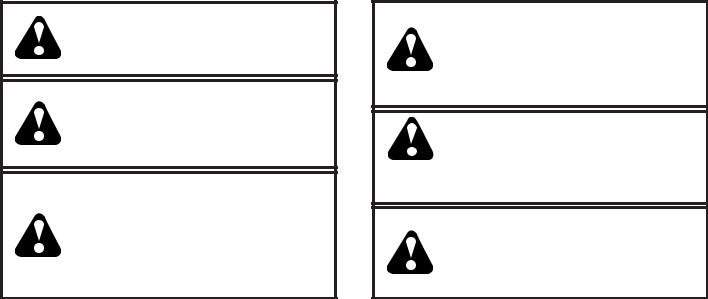
IMPORTANT
Safe Operation Practices for Walk-Behind Snow Throwers
This snow thrower is capable of amputating hands and feet and throwing objects. Failure to observe the following safety instructions could result in serious injury.
Look for this symbol to point out important safety precautions. It means CAUTION!!! BECOME ALERT!!! YOUR SAFETY IS INVOLVED.
WARNING: Always disconnect spark plug wire and place it where it cannot contact plug in order to prevent accidental starting when setting up, transporting, adjusting or making repairs.
WARNING: This snow thrower is for use on sidewalks, driveways and other ground level surfaces. Caution should beexercisedwhileusingonslopingsurfaces. Do not use snow thrower on surfaces above ground level such as roofs of residences, garages, porches or other such structures or buildings.
WARNING: Snow throwers have exposed rotating parts, which can cause severe injury from contact, or from material thrown from the discharge chute. Keep the area of operation clear of all persons, small children and pets at all times including startup.
CAUTION: Muffler and other engine parts become extremely hot during operation and remain hot after engine has stopped. To avoid severe burns on contact, stay away from these areas.
WARNING: Engine exhaust, some of its constituents, and certain vehicle components contain or emit chemicals known to the State of California to cause cancer and birth defects or other reproductive harm.
Training
1. Read, understand and follow all instructions on the |
|
(f) Keep the nozzle in contact with the rim of the fuel |
||
machine and in the manual(s) before operating this |
|
tank or container opening at all times, until refuel- |
||
unit. Be thoroughly familiar with the controls and the |
|
ing is complete. Do not use a nozzle lock-open |
||
proper use of the equipment. Know how to stop the |
|
device. |
||
unit and disengage the controls quickly. |
|
(g) Replace gasoline cap securely and wipe up spilled |
||
|
|
|
||
2. Never allow children to operate the equipment. Never |
|
fuel. |
||
allow adults to operate the equipment without proper |
|
(h) If fuel is spilled on clothing, change clothing im- |
||
instruction. |
|
|||
|
mediately. |
|||
3. Keep the area of operation clear of all persons, par- |
|
|||
5. Use extension cords and receptacles as specified by |
||||
ticularly small children. |
||||
|
the manufacturer for all units with electric drive motors |
|||
|
|
|
||
4. Exercise caution to avoid slipping or falling, especially |
|
or electric starting motors. |
||
when operating the snow thrower in reverse. |
6. Adjust the collector housing height to clear gravel or |
|||
|
|
|||
Preparation |
|
crushed rock surface. |
||
7. Never attempt to make any adjustments while the |
||||
1. Thoroughly inspect the area where the equipment is |
||||
|
engine (motor) is running (except when specifically |
|||
to be used and remove all doormats, sleds, boards, |
|
recommended by manufacturer). |
||
wires, and other foreign objects. |
8. Always wear safety glasses or eye shields during op- |
|||
2. Disengage all clutches and shift into neutral before |
||||
|
eration or while performing an adjustment or repair to |
|||
starting the engine (motor). |
|
protect eyes from foreign objects that may be thrown |
||
3. Do not operate the equipment without wearing adequate |
|
from the machine. |
||
winter garments. Avoid loose fitting clothing that can |
Operation |
|||
get caught in moving parts. Wear footwear that will |
||||
improve footing on slippery surfaces. |
1. Do not put hands or feet near or under rotating parts. |
|||
|
|
|||
4. Handle fuel with care; it is highly flammable |
|
Keep clear of the discharge opening at all times. |
||
(a) |
Use an approved fuel container. |
2. Exercise extreme caution when operating on or cross- |
||
(b) |
Never add fuel to a running engine or hot en- |
|
ing gravel drives, walks, or roads. Stay alert for hidden |
|
|
hazards or traffic. |
|||
|
gine. |
|
||
|
3. |
After striking a foreign object, stop the engine (motor), |
||
(c) Fill fuel tank outdoors with extreme care. Never fill |
||||
|
remove the wire from the spark plug, disconnect the |
|||
|
fuel tank indoors. |
|
||
|
|
cord on electric motors, thoroughly inspect the snow |
||
(d) Never fill containers inside a vehicle or on a truck |
|
|||
|
thrower for any damage, and repair the damage before |
|||
|
or trailer bed with a plastic liner. Always place |
|
restarting and operating the snow thrower. |
|
|
containers on the ground, away from your vehicle, |
4. If the unit should start to vibrate abnormally, stop the |
||
|
before filling. |
|||
|
|
engine (motor) and check immediately for the cause. |
||
(e) |
When practical, remove gas-powered equipment |
|
||
|
Vibration is generally a warning of trouble. |
|||
|
from the truck or trailer and refuel it on the ground. |
5. |
Stop the engine (motor) whenever you leave the oper- |
|
|
If this is not possible, then refuel such equipment |
|||
on a trailer with a portable container, rather than |
|
ating position, before unclogging the collector/impeller |
|
|
housing or discharge chute, and when making any |
||
from a gasoline dispenser nozzle. |
|
||
2 |
repairs, adjustments or inspections. |
||
|
|||
|
|
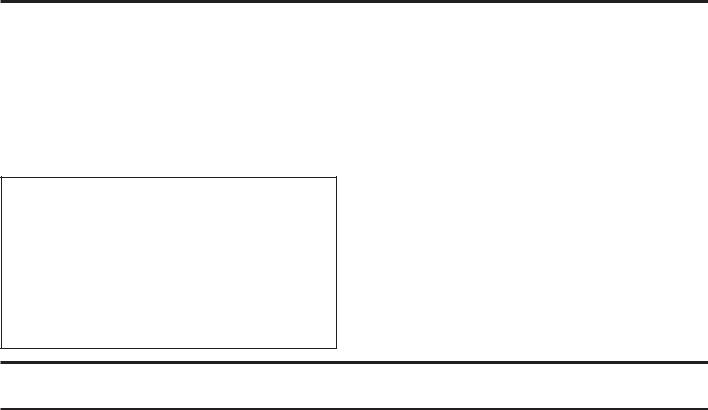
6.Whencleaning,repairingorinspectingthesnowthrower, stop the engine and make certain the collector/impeller and all moving parts have stopped. Disconnect the spark plug wire and keep the wire away from the plug to prevent someone from accidentally starting the engine.
7.Do not run the engine indoors, except when starting the engine and for transporting the snow thrower in or out of the building. Open the outside doors; exhaust fumes are dangerous.
8.Exercise extreme caution when operating on slopes.
9.Never operate the snow thrower without proper guards, and other safety protective devices in place and working.
10.Never direct the discharge toward people or areas where property damage can occur. Keep children and others away.
11.Do not overload the machine capacity by attempting to clear snow at too fast a rate.
12.Never operate the machine at high transport speeds on slippery surfaces. Look behind and use care when operating in reverse.
13.Disengage power to the collector/impeller when snow thrower is transported or not in use.
14.Use only attachments and accessories approved by the manufacturer of the snow thrower (such as wheel weights, counterweights, or cabs).
15.Never operate the snow thrower without good visibility or light. Always be sure of your footing, and keep a firm hold on the handles. Walk; never run.
16.Never touch a hot engine or muffler.
Clearing a Clogged Discharge Chute
Hand contact with the rotating impeller inside the discharge chute is the most common cause of injury associated with snow throwers. Never use your hand to clean out the discharge chute. To clear the chute:
1.SHUT THE ENGINE OFF!
2.Wait 10 seconds to be sure the impeller blades have stopped rotating.
3.Always use a clean-out tool, not your hands.
Maintenance and Storage
1.Check shear bolts and other bolts at frequent intervals for proper tightness to be sure the equipment is in safe working condition.
2.Never store the machine with fuel in the fuel tank inside a building where ignition sources are present such as hot water heaters, space heaters, or clothes dryers. Allow the engine to cool before storing in any enclosure.
3.Always refer to operator’s manual for important details if the snow thrower is to be stored for an extended period.
4.Maintain or replace safety and instruction labels, as necessary.
5.Run the machine a few minutes after throwing snow to prevent freeze-up of the collector/impeller.
CONGRATULATIONS on your purchase of a new snow thrower. It has been designed, engineered and manufactured to give best possible dependability and performance.
Should you experience any problem you cannot easily remedy, please contact your nearest authorized service center. We have competent, well-trained technicians and the proper tools to service or repair this unit.
Please read and retain this manual. The instructions will enable you to assemble and maintain your snow thrower properly. Always observe the “SAFETY RULES”.
SERIAL NUMBER: ___________________________
DATE OF PURCHASE: _______________________
THE MODEL AND SERIAL NUMBERS WILL BE FOUND ON A DECAL ATTACHED TO THE REAR OF THE SNOW THROWER HOUSING.
YOU SHOULD RECORD BOTH SERIAL NUMBER AND DATE OF PURCHASE AND KEEP IN A SAFE PLACE FOR FUTURE REFERENCE.
PRODUCT SPECIFICATIONS
Gasoline Capacity |
2.0 Quarts |
and Type: |
Unleaded Regular only |
|
|
Oil Type |
SAE 30 (above 40°F) |
(API SG–SL): |
SAE 5W-30 or 10W-30 (0° to +40°F) |
|
SAE 0W-30 (below 0°F) |
|
|
Oil Capacity: |
20 Ounces |
|
|
Spark Plug: |
Champion RN9YC (Gap: .030") |
|
|
CUSTOMER RESPONSIBILITIES
•Read and observe the safety rules.
•Follow a regular schedule in maintaining, caring for and using your snow thrower.
•Follow the instructions under “Maintenance” and “Storage” sections of this owner’s manual.
TABLE OF CONTENTS
SAFETY RULES ........................................................ |
2-3 |
PRODUCT SPECIFICATIONS...................................... |
3 |
CUSTOMER RESPONSIBILITIES................................ |
3 |
ASSEMBLY / PRE-OPERATION ............................... |
4-6 |
OPERATION ............................................................ |
7-12 |
MAINTENANCE SCHEDULE ..................................... |
13 |
MAINTENANCE..................................................... |
13-14 |
SERVICE AND ADJUSTMENTS........................... |
15-17 |
STORAGE................................................................... |
17 |
TROUBLESHOOTING................................................ |
18 |
REPAIR PARTS ..................................................... |
20-38 |
3 WARRANTY............................................... |
BACK PAGE |
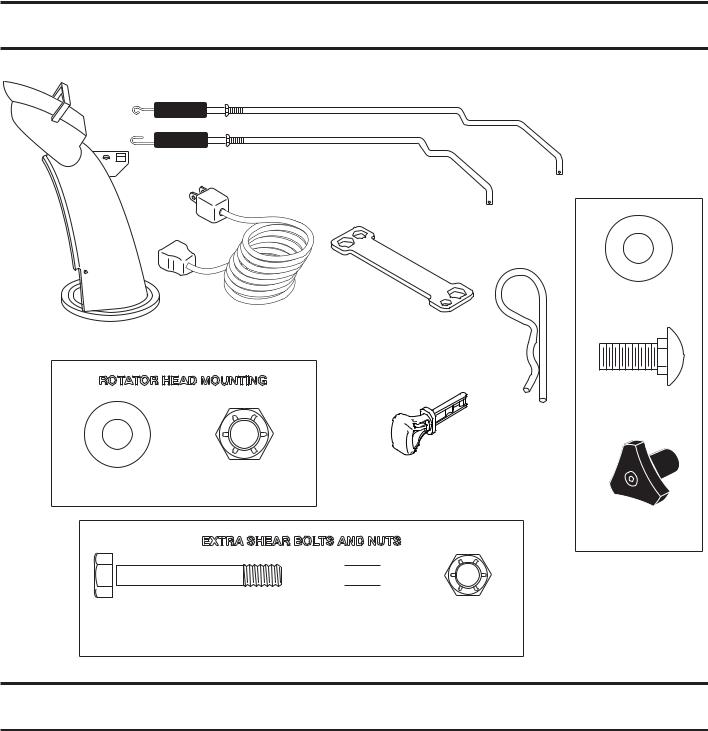
PARTS PACKED SEPARATELY IN CARTON
(1) AUGER CONTROL ROD
(1) TRACTION DRIVE CONTROL ROD
(1) MULTIWRENCH (180684)
(2) FLAT WASHERS
|
(1) POWER CORD |
|
(1) DISCHARGE CHUTE |
(198563) |
(3) RETAINER |
|
||
|
|
|
|
|
SPRINGS |
|
|
(169675) |
ROTATOR HEAD MOUNTING
(2) CARRIAGE BOLTS 3/8-16 x 2.25
(1) WASHER 3/8 |
(1) LOCKNUT 3/8 |
(1) SAFTEY IGNITION KEY |
|
(422663) |
|||
(19131316) |
(73800600) |
||
|
(2) HANDLE KNOBS
EXTRA SHEAR BOLTS AND NUTS
|
|
|
|
|
|
|
|
|
|
|
|
|
|
|
|
|
|
|
|
|
|
|
|
|
|
|
|
|
|
|
|
|
|
|
|
|
|
|
|
(6) SHEAR BOLTS 1/4-20 x 1-3/4 |
(6) SPACERS |
(6) LOCKNUTS |
|||||
(198636) |
|
(198638) |
1/4-20 |
||||
|
|
|
|
|
|
|
(73800400) |
ASSEMBLY / PRE-OPERATION
Read these instructions and this manual in its entirety |
2. |
Cut down all four corners of carton and lay panels flat. |
|
before you attempt to assemble or operate your new |
3. |
Remove the two (2) screws securing the auger housing |
|
snow thrower. Reading the entire manual will familiar- |
|||
|
to the pallet. |
||
ize you with the unit, which will assist you in assembly, |
|
||
4. |
Remove all packing materials except plastic tie holding |
||
operation and maintenance of the product. |
|||
|
speed control rod to lower handle. |
||
Your new snow thrower has been assembled at the factory |
|
||
5. |
Remove the two (2) plastic ties securing the upper |
||
with the exception of those parts left unassembled for ship- |
|||
|
handle to the pallet. |
||
ping purposes. All parts such as nuts, washers, bolts, etc., |
|
||
6. |
Remove snow thrower from carton and check carton |
||
necessary to complete the assembly have been placed in |
|||
the parts bag. To ensure safe and proper operation of your |
|
thoroughly for additional loose parts. |
|
snow thrower, all parts and hardware you assemble must |
HOW TO SET UP YOUR SNOW THROWER |
||
be tightened securely. Use the correct tools as necessary |
|||
|
|
||
to ensure proper tightness. |
TOOL BOX (See Fig. 8) |
||
REMOVE SNOW THROWER FROM CARTON |
A toolbox is provided on your snow thrower. The toolbox is |
||
located on top of the belt cover. Store the extra shear bolts, |
|||
1. Remove all accessible loose parts and parts boxes |
nuts and multi-wrench provided in parts bag in the toolbox. |
||
from carton. |
4 |
|
|
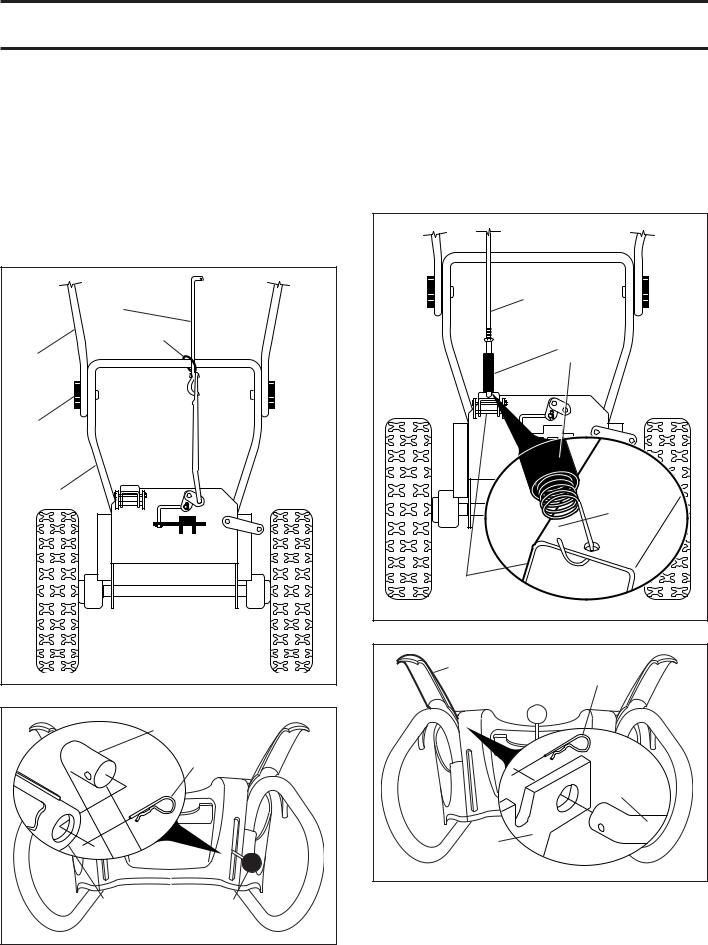
ASSEMBLY / PRE-OPERATION
NOTE: The multi-wrench may be used for assembly of the chute rotator head to snow thrower and making adjustments to the skid plates.
UNFOLD UPPER HANDLE
1.Raise upper handle to the operating position and tighten handle knobs securely. Additional carriage bolts, washers and handle knobs are in bag of parts. Use to secure upper handle to lower handle. Install in lower holes in handles.
INSTALL SPEED CONTROL ROD (See Figs. 1 and 2)
1.Remove plastic tie securing rod to lower handle.
2.Insert rod into speed control bracket and secure with retainer spring.
SPEED |
CONTROL |
ROD |
PLASTIC TIE |
UPPER |
HANDLE |
HANDLE |
KNOB |
LOWER |
HANDLE |
FIG. 1
SPEED CONTROL ROD |
|
|
RETAINER |
|
SPRING |
SPEED |
SPEED |
CONTROL |
CONTROL |
BRACKET |
LEVER |
FIG. 2
INSTALL TRACTION DRIVE CONTROL ROD (See Figs. 3 and 4)
The traction drive control rod has the long loop on the end of the spring as shown.
1.Slide rubber sleeve up rod and hook end of spring into pivot bracket with loop opening down as shown.
2.With top end of rod positioned under left side of control panel, push rod down and insert top end of rod into hole in drive control bracket. Secure with retainer spring.
TRACTION DRIVE |
CONTROL ROD |
RUBBER |
SLEEVE |
LOOP |
OPENING |
DOWN |
PIVOT |
BRACKET |
FIG. 3
TRACTION DRIVE |
RETAINER |
CONTROL LEVER |
SPRING |
|
TRACTION |
|
DRIVE |
|
CONTROL |
|
ROD |
DRIVE |
|
CONTROL |
|
BRACKET |
|
FIG. 4
5
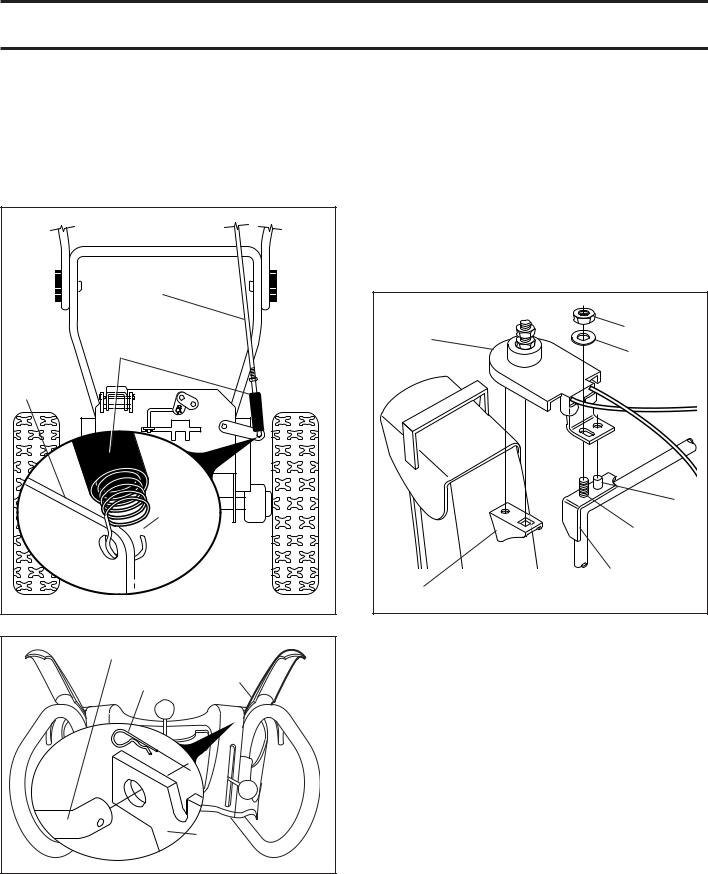
ASSEMBLY / PRE-OPERATION
INSTALL AUGER CONTROL ROD (See Figs. 5 and 6)
The auger control rod has the short loop on the end of the spring as shown.
1.Slide rubber sleeve up rod and hook end of spring into control arm with loop opening up as shown.
2.With top end of rod positioned under right side of control panel, push down on rod and insert end of rod into hole in auger control bracket. Secure with retainer spring.
AUGER |
CONTROL |
ROD |
RUBBER |
SLEEVE |
CONTROL |
ARM |
LOOP |
OPENING |
UP |
FIG. 5
AUGER CONTROL ROD |
AUGER |
|
RETAINER |
CONTROL |
|
LEVER |
||
SPRING |
||
|
||
|
AUGER |
|
CONTROL |
||
BRACKET |
||
FIG. 6
INSTALL DISCHARGE CHUTE / CHUTE ROTATER HEAD (See Fig. 7)
NOTE: The multi-wrench provided in your parts bag may be used to install the chute rotater head.
1.Place discharge chute assembly on top of chute base with discharge opening toward front of snow thrower.
2.Position chute rotater head over chute bracket. If necessary,rotatechuteassemblytoalignsquareandpinonunderside of chute rotater head with holes in chute bracket.
3.With chute rotater head and chute bracket aligned, position chute rotater head on pin and threaded stud of mounting bracket.
4.Install 3/8 washer and locknut on threaded stud and tighten securely.
CHUTE |
|
|
ROTATER |
|
3/8 LOCKNUT |
HEAD |
|
|
|
|
3/8 WASHER |
|
|
PIN |
|
|
THREADED |
|
|
STUD |
|
ALIGN BEFORE |
ROTATER HEAD |
CHUTE |
MOUNTING |
|
BRACKET |
TIGHTENING LOCKNUT |
BRACKET |
FIG. 7
CHECK TIRE PRESSURE
The tires on your snow thrower were overinflated at the factory for shipping purposes. Correct and equal tire pressure is important for best snow throwing performance.
•Reduce tire pressure to 14-17 PSI (19-24.5 N-m).
6

OPERATION
KNOW YOUR SNOW THROWER
READ THIS OWNER'S MANUAL AND ALL SAFETY RULES BEFORE OPERATING YOUR SNOW THROWER. Compare the illustrations with your snow thrower to familiarize yourself with the location of various controls and adjustments. Save this manual for future reference.
These symbols may appear on your snow thrower or in literature supplied with the product. Learn and understand their meaning.
DANGER |
|
|
|
|
|
|
|
|
|
PRIMER |
|
|
|
|
|
|
|
|
|
||
|
|
|
|
|
|
|
|
|
||
|
|
|
|
|
|
|
||||
|
|
|
||||||||
OR WARNING
READ AND FOLLOW ALL SAFETY INFORMATION
AND INSTRUCTIONS BEFORE USE OF THIS PRODUCT. FORWARD REVERSE KEEP THESE INSTRUCTIONS FOR FUTURE REFERENCE.
IGNITION KEY. |
|
INSERT TO START |
|
AND RUN, |
|
PULL OUT TO STOP. |
|
DISENGAGED |
|
ENGAGED |
|
SNOW |
TRACTION |
DISCHARGE |
DRIVE CONTROL |
|
7 |
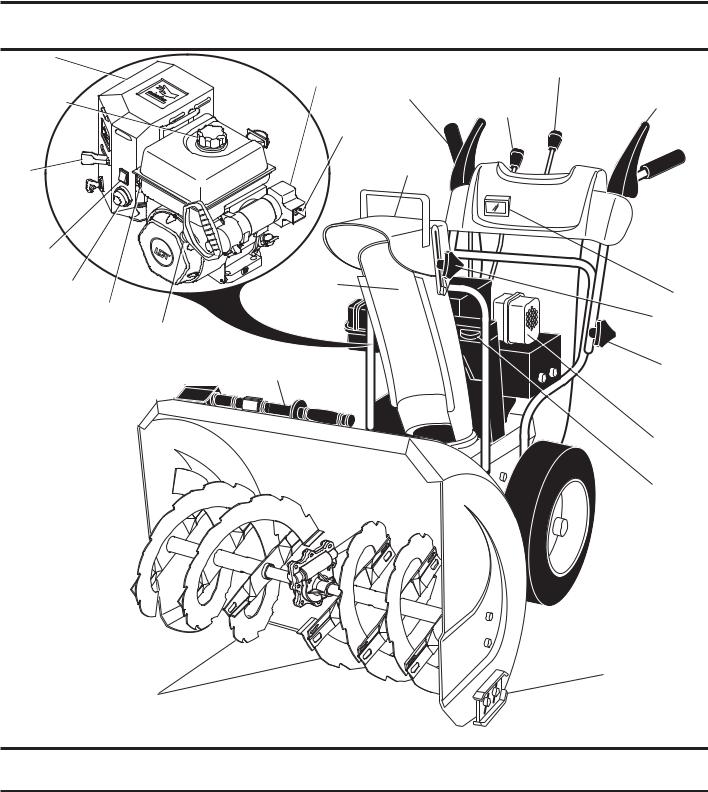
OPERATION
MUFFLER
GASOLINE
FILLER CAP
CHOKE
CON-
TROL
SAFETY
IGNITION
KEY
ON / OFF
SWITCH
PRIMER
FUEL SHUT-OFF VALVE
RECOIL (AUXILIARY) STARTER HANDLE
NOTE: ITEMS ABOVE
ARE SHOWN IN
THEIR TYPICAL
LOCATION ON THE
ENGINE. ACTUAL
LOCATION MAY VARY
WITH THE ENGINE
ON YOUR UNIT.
AUGERS
ELECTRIC
START AUGER
BUTTON CONTROL
LEVER
POWER
CORD
PLUG
CHUTE
DEFLECTOR
CLEAN-OUT TOOL
FIG. 8
DISCHARGE CHUTE CONTROL LEVER
DRIVE SPEED |
TRACTION |
CONTROL LEVER |
DRIVE |
|
CONTROL |
|
LEVER |
LIGHT
CHUTE
DEFLECTOR
KNOB
HANDLE
KNOB
MUFFLER
TOOLBOX
SKID PLATE
MEETS A.N.S.I. SAFETY REQUIREMENTS
Our snow throwers conform to the standards of the American National Standards Institute.
Toolbox - used to store spare shear bolts, locknuts and wrench.
Safety ignition key - must be inserted for the engine to start and run. Remove when snow thrower is not in use.
Electric start button – used for starting the engine.
Recoil (auxiliary) starter handle – used for starting the engine.
Primer - pumps additional fuel from the carburetor to the cylinder for use when starting a cold engine.
ON / OFF switch - used to STOP the engine.
Choke control - used for starting a cold engine.
Drive speed control lever - used to select forward or reverse motion and speed of snow thrower.
Traction drive control lever - used to engage power-pro- pelled forward or reverse motion of snow thrower.
Auger control lever - used to engage auger motion (throw snow).
Discharge chute control lever - used to change the direction the snow is thrown.
Skid plate - used to adjust height of scraper bar from the 8 ground.
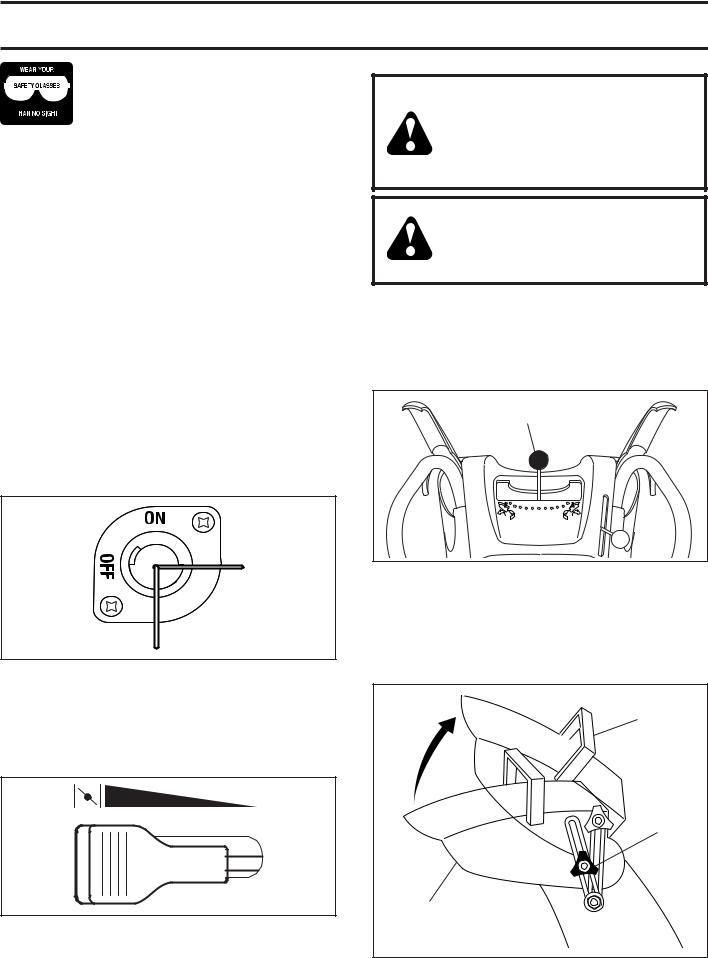
OPERATION
The operation of any snow thrower can result in foreign objects thrown into the eyes, which can result in severe eye damage. Always wear







 safety glasses or eye shields while operating your snow thrower or performing any adjustments or repairs. We recommend standard safety glasses
safety glasses or eye shields while operating your snow thrower or performing any adjustments or repairs. We recommend standard safety glasses
or a wide vision safety mask worn over spectacles.
HOW TO USE YOUR SNOW THROWER
Know how to operate all controls before adding fuel or attempting to start the engine.
STOPPING
TRACTION DRIVE
•Release traction drive control lever to stop the forward or reverse movement of the snow thrower.
AUGER
• Release the auger control lever to stop throwing snow. ENGINE
1.Move throttle control to “STOP” position.
2.Remove (do not turn) safety ignition key to prevent unauthorized use.
NOTE: Never use choke to stop engine.
TO USE FUEL SHUT-OFF VALVE (See Fig. 9)
The fuel shut-off valve is located beneath the fuel tank on the engine. Always operate the snow thrower with the fuel shut-off valve in the OPEN position.
OFF
OPEN
FIG. 9
TO USE CHOKE CONTROL (See Fig. 10)
The choke control is located on the engine. Use the choke control whenever you are starting a cold engine. Do not use to start a warm engine.
•To engage choke, rotate lever to “FULL” position.
FULL |
OFF |
FIG. 10
TO CONTROL SNOW DISCHARGE (See Figs. 11 & 12)
WARNING: Snow throwers have exposed rotating parts, which can cause severe injury from contact, or from material thrown from the discharge chute. Keep the area of operation clear of all persons, small children and pets at all times including startup.
WARNING: If the discharge chute or auger become clogged, shut-off engine andwaitforallmovingpartstostop.Use the clean-out tool, NOT YOUR HANDS, to unclog the chute and/or auger.
The DIRECTION in which snow is to be thrown is controlled by the discharge chute control lever.
•To change the discharge chute position, press downward on discharge chute control lever and move lever left or right until chute is in desired position. Be sure lever springs back and locks into desired position.
DISCHARGE CHUTE
CONTROL LEVER
FIG. 11
The DISTANCE that snow is thrown is controlled by the position of the chute deflector. Set the deflector low to throw snow a short distance; set the deflector higher to throw snow farther.
•To change the deflector position, loosen knob, move deflector to desired position and tighten knob securely.
HIGH
POSITION
KNOB
CHUTE
DEFLECTOR
LOW POSITION
FIG. 12
9
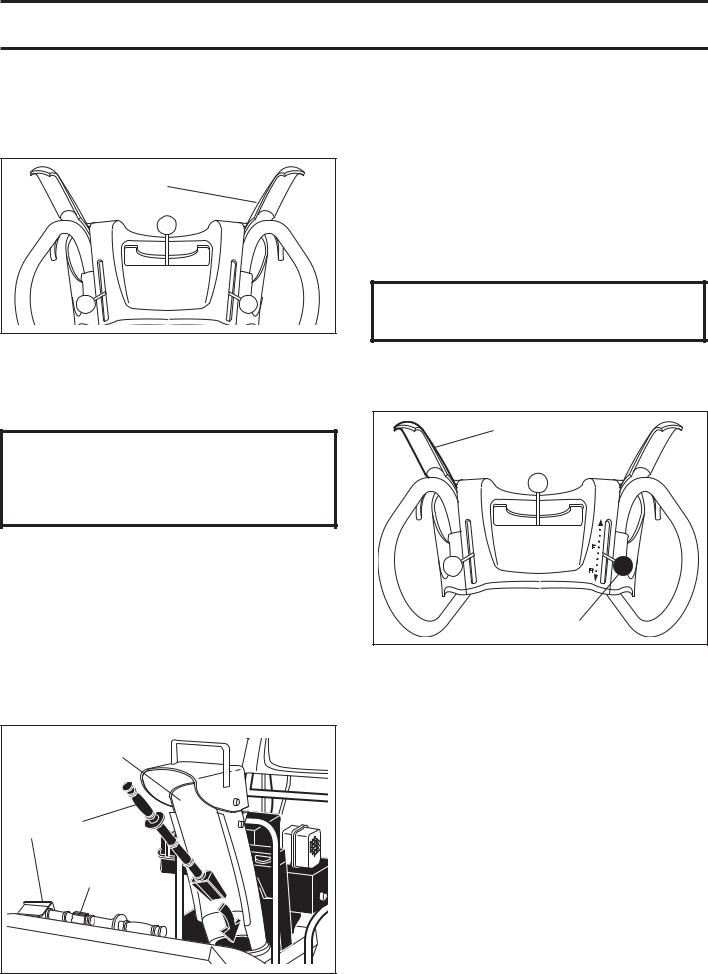
OPERATION
TO THROW SNOW (See Fig. 13)
The auger rotation is controlled by the auger control lever located on the right side handle.
•Squeeze auger control lever to handle to engage the auger and throw snow.
•Release the auger control lever to stop throwing snow.
AUGER
CONTROL
LEVER
FIG. 13
USING THE CLEAN-OUT TOOL (See Fig. 14)
In certain snow conditions, the discharge chute may become clogged with ice and snow. Use the clean-out tool to dislodge this blockage.
When cleaning, repairing, or inspecting, make certain all controls are disengaged and the auger/impeller and all moving parts have stopped. Disconnect the spark plug wire and keep the wire away from the spark plug to prevent accidental starting.
•Release the auger control lever and shut off the engine.
•Remove the clean-out tool from it's mounting clip. Grasp the tool firmly by the handle and push and twist the tool into the discharge chute to dislodge the blockage.
After the packed snow has been dislodged, return the cleanout tool to it's mounting clip by pushing it into the clip.
•Make sure the discharge chute is pointed in a safe direction (no vehicles, buildings, people, or other objects are in the direction of discharge) before restarting engine.
•Restart the engine, then squeeze the auger control lever to the handle to clear snow from the auger housing and the discharge chute.
DISCHARGE CHUTE |
|
CLEAN-OUT |
|
TOOL |
|
MOUNTING |
|
CLIP |
|
FIG. 14 |
10 |
TO MOVE FORWARD AND BACKWARD (See Fig. 15)
SELF-PROPELLING, forward and reverse movement of the snow thrower, is controlled by the traction drive control lever located on the left side handle.
•Squeeze traction drive control lever to handle to engage the drive system.
•Release traction drive control lever to stop the forward or reverse movement of the snow thrower.
SPEED and DIRECTION are controlled by the drive speed control lever.
•Press downward on the speed control lever and move lever to desired position BEFORE engaging the traction drive control lever. Be sure lever springs back and locks into desired position.
CAUTION: Do not move speed control lever when traction drive control lever is engaged. Damage to the snow thrower can result.
•Slower speeds are for heavier snow and faster speeds are for light snow and transporting the snow thrower. It is recommended that you use a slower speed until you are familiar with the operation of the snow thrower.
TRACTION DRIVE |
CONTROL LEVER |
DRIVE SPEED |
CONTROL LEVER |
FIG. 15
TO ADJUST SKID PLATES (See Fig. 16)
NOTE: The wrench provided in your parts bag may be used to adjust the skid plates.
Skid plates are located on each side of the auger housing and adjust the clearance between the scraper bar and the ground surface. Adjust skid plates evenly to proper height for current surface conditions. For removal of snow in normal conditions, such as a paved driveway or sidewalk, place skid plates in the highest position (lowest scraper clearance) to give a 1/8" clearance between the scraper bar and the ground. Use a middle position if the surface to be cleared is uneven.
NOTE: It is not recommended to operate the snow thrower over gravel or rocky surfaces. Objects such as gravel, rocks or other debris, can easily be picked up and thrown by the impeller, which can cause serious personal injury, property damage or damage to the snow thrower.
•If snow thrower must be operated over gravel surface, use extra caution and be sure skid plates are adjusted to lowest (highest scraper clearance) position.
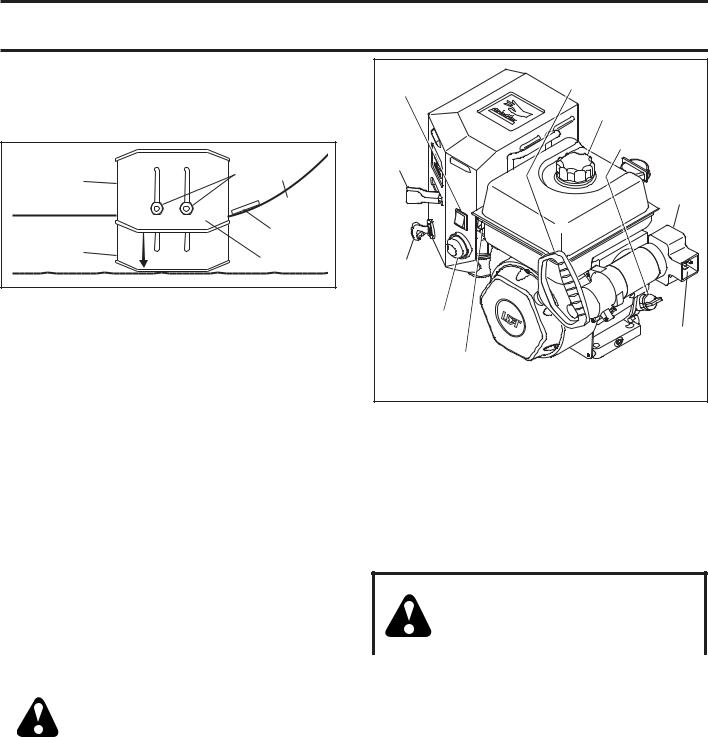
|
|
OPERATION |
|
||
1. |
Shut off engine and wait for all moving parts to stop. |
ON / OFF |
RECOIL (AUXILIARY) |
||
STARTER HANDLE |
|||||
2. Adjust skid plates by loosening the hex nuts, then mov- |
SWITCH |
||||
|
|||||
|
GASOLINE |
||||
|
ing skid plate to desired position. Be sure both plates |
|
FILLER CAP |
||
|
are adjusted evenly. Tighten securely. |
|
ENGINE OIL FILL |
||
|
|
|
CHOKE |
||
|
|
|
CAP / DIPSTICK |
||
|
|
|
CON- |
||
HIGH POSITION |
|
|
|||
HEX |
TROL |
|
|||
(LOW GROUND |
|
||||
|
|
||||
CLEARANCE) |
NUTS |
|
STARTER |
||
|
|
|
|
||
|
|
AUGER |
|
BUTTON |
|
|
|
|
|
||
|
|
HOUSING |
|
|
|
LOW POSITION |
SCRAPER |
|
|
||
(HIGH GROUND |
BAR |
|
|
||
CLEARANCE) |
SKID PLATE |
|
|
||
|
|
SAFETY |
|
||
|
|
|
|
||
|
|
|
IGNITION |
|
|
|
FIG. 16 |
|
KEY |
|
|
|
|
|
|
||
SCRAPER BAR (See Fig. 16) |
|
PRIMER |
|
||
The scraper bar is not adjustable, but is reversible. After |
|
POWER |
|
considerable use it may become worn. When it has worn |
|
CORD |
|
almost to the edge of the housing, it can be reversed, |
FUEL SHUT-OFF VALVE |
PLUG |
|
providing additional service before requiring replacement. |
NOTE: ALL ITEMS ARE SHOWN IN THEIR TYPICAL LOCATION. |
||
Replace a damaged or worn scraper bar. |
ACTUAL LOCATION MAY VARY WITH ENGINE ON YOUR UNIT. |
||
BEFORE STARTING THE ENGINE |
|
FIG. 17 |
|
TO START ENGINE |
|
||
CHECK ENGINE OIL LEVEL (See Fig. 17) |
|
||
• Be sure fuel shut-off valve is in the “OPEN” position. |
|||
The engine on your snow thrower has been shipped, from |
|||
Your snow thrower engine is equipped with both a 120 Volt |
|||
the factory, already filled with oil. |
|||
A.C. electric starter and a recoil starter. The electric starter |
|||
1. Check engine oil with snow thrower on level ground. |
|||
is equipped with a three-wire power cord and plug and is |
|||
|
|||
2. Remove oil fill cap/dipstick and wipe clean, reinsert |
designed to operate on 120 Volt A.C. household current. |
||
the dipstick and screw tight, wait for a few seconds, |
• Be sure your house is a 120 Volt A.C. three-wire |
||
remove and read oil level. If necessary, add oil until |
|||
grounded system. |
If you are uncertain, consult a |
||
“FULL” mark on dipstick is reached. Do not overfill. |
|||
licensed electrician. |
|
||
|
|
||
•To change engine oil, see “TO CHANGE ENGINE OIL”
in the Maintenance section of this manual. |
|
|
WARNING: Do not use the electric |
|
ADD GASOLINE (See Fig. 17) |
|
|
starter if your house is not a 120 Volt |
|
|
|
A.C. three-wire grounded system. Seri- |
||
• Fill fuel tank to bottom of tank filler neck. Do not over- |
|
|
||
|
|
ous personal injury or damage to your |
||
fill. Use fresh, clean, regular unleaded gasoline with a |
|
|
snow thrower could result. |
|
minimum of 87 octane. Do not mix oil with gasoline. |
|
|
|
|
Purchase fuel in quantities that can be used within 30 |
|
COLD START - ELECTRIC STARTER |
||
days to assure fuel freshness. |
|
|||
1. |
Insert safety ignition key (packed separately in parts |
|||
|
||||
WARNING: Wipe off any spilled oil or |
|
|
bag) into ignition slot until it clicks. DO NOT turn the key. |
|
fuel. Do not store, spill or use gasoline |
|
|
Keep the extra safety ignition key in a safe place. |
|
near an open flame. |
2. |
Place ON / OFF switch in “ON” position. |
||
|
3. |
Move choke control to “FULL” position. |
||
|
||||
CAUTION: Alcohol blended fuels (called gaso- |
4. |
Connect the power cord to the engine. |
||
hol or using ethanol or methanol) can attract |
5. |
Plug the other end of the power cord into a three-hole |
||
moisture which leads to separation and forma- |
||||
|
|
grounded 120 Volt A.C. receptacle. |
||
tion of acids during storage. Acidic gas can |
|
|
||
|
NOTE: Do not use primer when starting engine with the |
|||
damage the fuel system of an engine while in |
|
|||
storage. To avoid engine problems, the fuel |
|
electric starter. |
||
system should be emptied before storage of |
6. |
Push starter button until engine starts. |
||
30 days or longer. Empty the gas tank, start |
|
IMPORTANT: Do not crank engine more than five continu- |
||
the engine and let it run until the fuel lines |
|
|||
and carburetor are empty. Use fresh fuel next |
|
ous seconds between each time you try to start. Wait 5 to |
||
season. SeeStorageInstructionsforadditional |
|
10 seconds between each attempt. |
||
information. Never use engine or carburetor |
7. |
When the engine starts, release the starter button and |
||
cleaner products in the fuel tank or permanent |
|
|
slowly move the choke control to the “OFF” position. |
|
damage may occur. |
8. |
Disconnect the power cord from the receptacle first, |
||
|
||||
|
11 |
|
then from the engine. |
|
|
|
|
||
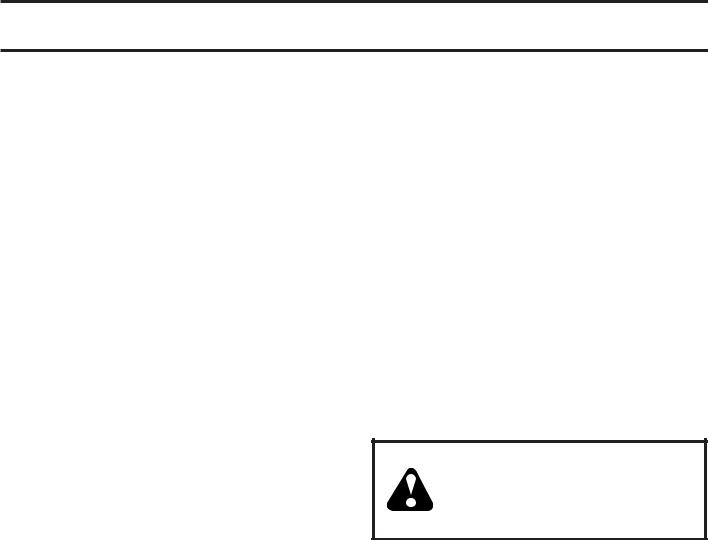
OPERATION
Allow the engine to warm up for a few minutes. Engine will not develop full power until it has reached normal operating temperature.
WARM START - ELECTRIC STARTER
Follow the steps above, keeping the choke control in the “OFF” position.
COLD START - RECOIL STARTER
1.Insert safety ignition key (packed separately in parts bag) into ignition slot until it clicks. DO NOT turn the key. Keep the extra safety ignition key in a safe place.
2.Place ON / OFF switch in “ON” position.
3.Rotate choke control to “FULL” position.
4.Push the primer four (4) times if the temperature is below 15°F, or two (2) times if temperature is between 15° and 50°F. If temperature is above 50°F, priming is not necessary.
NOTE: Over priming may cause flooding, preventing the engine from starting. If you do flood the engine, wait a few minutes before attempting to start and DO NOT push the primer.
5.Pull recoil starter handle quickly. Do not allow starter rope to snap back.
6.When the engine starts, release the recoil starter handle and slowly move the choke control to the “OFF” position.
Allow the engine to warm up for a few minutes. Engine will not develop full power until it has reached normal operating temperature.
WARM START - RECOIL STARTER
Follow the steps above, keeping the choke in the “OFF” position. DO NOT push the primer.
BEFORE STOPPING
Run the engine for a few minutes to help dry off any moisture on the engine.
IF RECOIL STARTER HAS FROZEN
If the recoil starter has frozen and will not turn the engine, proceed as follows:
1.Grasp the recoil starter handle and slowly pull as much rope out of the starter as possible.
2.Release the recoil starter handle and let it snap back against the starter.
If the engine still fails to start, repeat the above steps or use the electric starter.
SNOW THROWING TIPS
•Go slower in deep, freezing or heavy wet snow. Use the drive speed control, NOT the ON / OFF switch, to adjust speed.
•It is easier and more efficient to remove snow immediately after it falls.
•The best time to remove snow is the early morning. At this time the snow is usually dry and has not been exposed to the direct sun and warming temperatures.
•Slightly overlap each successive path to ensure all snow will be removed.
•Throw snow downwind whenever possible.
•Adjust the skid plates to proper height for current snow conditions. See “TO ADJUST SKID PLATES” in this section of this manual.
•For extremely heavy snow, reduce the width of snow removal by overlapping previous path and moving slowly.
•Keep engine clean and clear of snow during use. This will help air flow and extend engine life.
•Aftersnow-throwingiscompleted,allowenginetorunfor a few minutes to melt snow and ice off the engine.
•Clean the entire snow thrower thoroughly after each use and wipe dry so it is ready for next use.
WARNING: Do not operate snow thrower if weather conditions impair visibility. Throwing snow during a heavy, windy snowstorm can blind you and be hazardous to the safe operation of the snow thrower.
12
